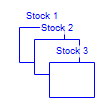
If you build a model or an interface with overlapping objects, some will draw on top of others, potentially partially obscuring them. The drawing precedence, usually referred to as the z-order, is based on both order of creation and object type. On the interface window, you can also further control appearance by sending objects to the front or back.
For objects of the same type, when you add a new one, it will be drawn on top of anything that's already there. For example, if you add three stocks in a row, and put them on top of one another, you'll see that the third obscures the second, which obscures the first:

When working with models, there's little that can be done about order of creation. It may be possible to change appearance by cutting and pasting, which can bring something on top. This works reasonably well with things that aren't building blocks.
Different objects draw first, in order to give the model a sensible appearance. The order of drawing from first (most in the background) to last (most in the foreground) is:
Note that parts of objects are, or can be made, transparent, so not everything will be obscured. This is most important for text boxes, which can be made transparent so only the text, and not the background, is visible, and the objects behind the text box are shown plainly.
Usually, the default ordering will give you the results you want. You can, however, send things to the back or front of the z-order. When an object is sent behind, it will draw behind regardless of its type, and likewise for sending something to the front. To get the exact effect you want, you may need to send things behind or in front in sequence. For example, if you want A to obscure B to obscure C, but all of them to be behind everything else, first send A behind, then B, then C.
To send something in front or behind, right-click or Ctrl-click (⌘-click on mac), and select Send to Front or Send to Back.
If you're using templates, be careful modifying z-order. Generally, you should only send things in the templates to the back, and send things on story and interface pages to the front.